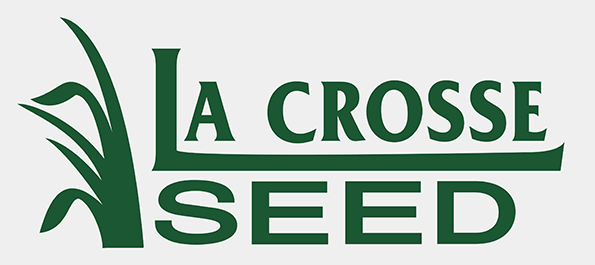Seed categories and product pages can be accessed from this menu:
La Crosse Seed Product Tech Sheets
For general Information regarding this species, scroll below the list of tech sheet links.
General Information Concerning Forage Mixes
Characteristics
Each Forage First® pasture mix is designed with specific goals in mind, and includes improved varieties of forage grasses and legumes selected for superior establishment, persistence, winter hardiness, palatability, yield, drought and grazing tolerance. Visit each product page for more detail.
Types
Our pasture mix portfolio has many options suited to your unique operation and goals. Explore below, or see a brochure of all our Forage First® mixes.
All Grass Forage Mixes
Our all grass mixes feature premium blends of elite performing forage grass varieties (sod-forming and non sod-forming), including endophyte fungus free.
Grass + Legume Forage Mixes
Our grass and legume mixes offer improved varieties of forage grasses and legumes designed for high forage production and nutritional value. These also include CrosseCoat®, an elite seed coating and treatment platform to enhance establishment.
Dairy Forage Mixes
Only with top quality forages can dairy cattle receive proper nutrition to maximize milk production and performance. Each Forage First® dairy pasture mix contains the right balance of nutrition, minerals and protein to provide energy for healthy cattle.
Beef Forage Mixes
Our beef pasture mixes enhance animal digestibility and performance by offering nutritious, palatable, high protein options for maximum daily gain.
Horse Pasture Mixes
Whether your horses are high energy or less active, our horse pasture mixes produce highly palatable forage with excellent yield. Each mix is adapted over a wide geography.
Pea Forage Mixes
Our SiloBuster Pea Oat, Pea Triticale and Pea Barley mixes offer an elite combination of quality forage peas and forage oats, triticale or barley for nurse crops or straight forage.
Many Forage First® mixes are also excellent for sheep, goat, and other animals.
Planting Times
Best in early spring or fall when weather is cooler and moisture is reliable.
Planting Directions
New Pasture
- Test soil and fertilize according to soil test recommendations or consult local agronomist or extension agency for recommendations
- Prepare fine, firm, clean seedbed tilled to 2-4 in. If no-tilling, use chemical burndown to remove competition.
- Broadcast or direct seed at recommended rates
- Generally, do not plant deeper than ½ in., with smaller-seeded species seeded at ¼ in. For best results, cultipack after broadcasting to assure good seed-to-soil contact.
- Do not graze until pasture is 8-10 in. high, then do not graze lower than 2-3 in.
- When mechanically harvesting for hay, leave 3-4 in. of plant growth
- Improved perennial pastures can typically support an animal unit/acre with adequate moisture and fertility. In areas with limited rainfall and/or fertility, an increase in acres/animal unit is required. Consult local expert in determining pasture stocking rates.
Overseeding
- Consult local agronomist or extension agency for the best methods in your region.
Seeding Methods
Seedbed should be firm to ensure good soil-to-seed contact, which is essential to increase germination, establishment and seedling health.
Drill: Drill seed by use of a Brillion grass or No-Till drill. Ensures best soil-to-seed contact when planted at depth of 1/8-1/4 in. Seed depth varies by soil type, season and available moisture. Consult local agronomist on preferred seeding depths in your region.
Broadcast: Seed by broadcast spreader or hand. Broadcast seeding is not recommended since it does not ensure soil contact nor accurate seed placement. If broadcast seeding is only option, follow with a drag or a cultipacker to push seed into top 1/8-1/4 in. of soil.
Frost: Frost seeding in spring takes advantage of available moisture and reduced weed competition.
Frost seeding legumes and grasses is an efficient way to improve pasture yields or change forage composition within the pasture and has several benefits over traditional plantings including:
- Ability to establish forage in undisturbed sod bed
- Reduced need for labor and energy
- Minimum equipment investment
- Shortened “non-grazing” period
- Maintains stand productivity for grasses and legumes
As with other methods, soil contact is essential. This can be achieved by grazing closely in fall or winter, down to 2 in., to open stands and expose soil. Sod-type grasses (bluegrass, brome, bermudagrass) are most difficult to frost seed, especially when a thick layer of thatch covers soil surface. Here, a limited amount of animal hoof action can help “plant” seed. Preferred species are festulolium, ryegrass, orchardgrass, ladino and red clover.
In spring, it’s important to reduce plant competition so new seedlings develop adequate root systems. By grazing down to 2 in. in fall, spring regrowth from established plants is slowed down, allowing seedlings to take hold.
Pasture Renovation
Ideally, it’s best to disk pasture and grow an annual crop (i.e., corn or oats) for one year and seed pasture the following year. Annual crops help remove broadleaf and grass weeds with strong root systems, destroy mole runs, break compacted sod and allow good seedbed preparation.
An alternative method is to rotovate pasture in late fall and leave tilled over winter. Then, work new seedbed in spring by rotovation or plow, followed by dragging into a smooth, firm seedbed. All past plants must be buried so they don’t regrow.
Early spring seeding offers the greatest opportunity for success. Later plantings may suffer during summer droughts since they don’t have the root structure to survive. Also, bacterial nodulation of legumes slows when plants are under moisture stress and weeds become more competitive. If you must plant during the summer, irrigate sufficiently.
Early fall planting can also be successful, depending on moisture levels and temperatures. It is important the seedling is established 45-60 days before freezing temperatures so plants get adequate root systems established.





